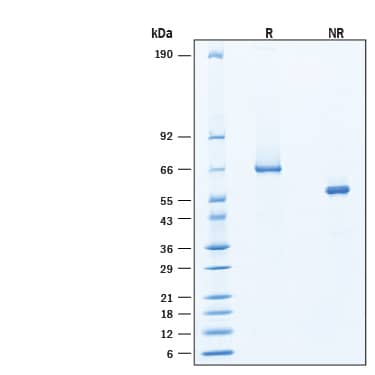Recombinant Human ADAM9 His-tag Protein, CF
R&D Systems, part of Bio-Techne | Catalog # 939-ADB

Key Product Details
- R&D Systems HEK293-derived Recombinant Human ADAM9 His-tag Protein (939-ADB)
- Quality control testing to verify active proteins with lot specific assays by in-house scientists
- All R&D Systems proteins are covered with a 100% guarantee
Source
HEK293
Accession #
Structure / Form
Mature form
Conjugate
Unconjugated
Applications
Enzyme Activity
Product Specifications
Source
Human embryonic kidney cell, HEK293-derived human ADAM9 protein
Ala206-Asp697, with a C-terminal 10-His tag
Ala206-Asp697, with a C-terminal 10-His tag
Purity
>95%, by SDS-PAGE visualized with Silver Staining and quantitative densitometry by Coomassie® Blue Staining.
Endotoxin Level
<0.10 EU per 1 μg of the protein by the LAL method.
N-terminal Sequence Analysis
Ala206
Predicted Molecular Mass
55 kDa
SDS-PAGE
61-68 kDa, under reducing conditions.
Activity
Measured by its ability to cleave a fluorogenic peptide substrate Mca-PLAQAV-Dpa-RSSSR-NH2 (Catalog # ES003).
The specific activity is >5 pmol/min/μg, as measured under the described conditions.
The specific activity is >5 pmol/min/μg, as measured under the described conditions.
Scientific Data Images for Recombinant Human ADAM9 His-tag Protein, CF
Recombinant Human ADAM9 His-tag Protein SDS-PAGE.
2 μg/lane of Recombinant Human ADAM9 His-tag Protein (Catalog # 939-ADB) was resolved with SDS-PAGE under reducing (R) and non-reducing (NR) conditions and visualized by Coomassie® Blue staining, showing bands at 61-68 kDa, under reducing conditions.Formulation, Preparation and Storage
939-ADB
| Formulation | Supplied as a 0.2 μm filtered solution in MES and NaCl. |
| Shipping | The product is shipped with polar packs. Upon receipt, store it immediately at the temperature recommended below. |
| Stability & Storage | Use a manual defrost freezer and avoid repeated freeze-thaw cycles.
|
Background: ADAM9
References
- Moss, M.L. et al. (2001) Drug Discov. Today 6:417.
- Chou, C.W, et al. (2020) Int. J. Mol. Sci. 21:7790.
- Roghan, M. et al. (1999) J. Biol. Chem. 274:3531.
- Schwettmann, L. and H. Tschesche (2001) Prot. Express. & Purif. 21:65.
- Nath, D. et al. (2000) J. Cell Sci. 113:2319.
- Zhou, M. et al. (2001) Biochem. Biophys. Res. Comm. 280:574.
- Izumi, Y. et al. (1998) EMBO J. 17:7260.
- Howard, L. et al. (1999) J. Biol. Chem. 274:31693.
- Cong, L. and J. Jia (2011) Neurobiol. Aging 32:54.
- Zhang, J. et al. (2014) J. Cancer Res. Clin. Oncol. 140:1441.
- Hua, Y. et al. (2018) Oncol. Lett. 15:9051.
- Liu, R. et al. (2018) Onco. Targets Ther. 11:4065.
- Wang, X. et al. (2018) Am. J. Respir. Crit. Care Med. 198:1500.
- Xing, C. et al. (2019) Artif. Cells Nanomed. Biotechnol. 47:3920.
- Oh, S. et al. (2020) Cancers 12:745.
Long Name
A Disintegrin and Metalloprotease-like Domain 9
Alternate Names
MCMP, MDC9, Meltrin gamma
Gene Symbol
ADAM9
UniProt
Additional ADAM9 Products
Product Documents for Recombinant Human ADAM9 His-tag Protein, CF
Product Specific Notices for Recombinant Human ADAM9 His-tag Protein, CF
For research use only
